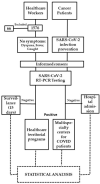A SARS-CoV-2 Infection High-Uptake Program on Healthcare Workers and Cancer Patients of the National Cancer Institute of Naples, Italy
- PMID: 35206819
- PMCID: PMC8872409
- DOI: 10.3390/healthcare10020205
A SARS-CoV-2 Infection High-Uptake Program on Healthcare Workers and Cancer Patients of the National Cancer Institute of Naples, Italy
Abstract
Background: From the beginning of 2020, Severe Acute Respiratory Syndrome Coronavirus 2 (SARS-CoV-2) quickly spread worldwide, becoming the main problem for the healthcare systems. Healthcare workers (HCWs) are at higher risk of infection and can be a dangerous vehicle for the spread of the virus. Furthermore, cancer patients (CPs) are a vulnerable population, with an increased risk of developing severe and lethal forms of Coronavirus Disease 19 (COVID-19). Therefore, at the National Cancer Institute of Naples, where only cancer patients are treated, a surveillance program aimed to prevent the hospital access of SARS-CoV-2 positive subjects (HCWs and CPs) was implemented. The study aims to describe the results of the monitoring activity for the SARS-CoV-2 spread among HCWs and CPs, from March 2020 to March 2021.
Methods: This surveillance program included a periodic sampling through nasopharyngeal molecular swabs for SARS-CoV-2 (Real-Time Polymerase Chain Reaction, RT-PCR). CPs were submitted to the molecular test at least 48 h before hospital admission. Survival analysis and multiple logistic regression models were performed among HCWs and CPs to assess the main SARS-CoV-2 risk factors.
Results: The percentages of HCWs tested with RT-PCR for the detection of SARS-CoV-2, according to the first and the second wave, were 79.7% and 91.7%, respectively, while the percentages for the CPs were 24.6% and 39.6%. SARS-CoV-2 was detected in 20 (1.7%) HCWs of the 1204 subjects tested during the first wave, and in 127 (9.2%) of 1385 subjects tested in the second wave (p < 0.001); among CPs, the prevalence of patients tested varied from 100 (4.6%) during the first wave to 168 (4.9%) during the second wave (p = 0.8). The multivariate logistic analysis provided a significant OR for nurses (OR = 2.24, 95% CI 1.23-4.08, p < 0.001) compared to research, administrative staff, and other job titles.
Conclusions: Our findings show that the positivity rate between the two waves in the HCWs increased over time but not in the CPs; therefore, the importance of adopting stringent measures to contain the shock wave of SARS-CoV-2 infection in the hospital setting was essential. Among HCWs, nurses are more exposed to contagion and patients who needed continuity in oncological care for diseases other than COVID-19, such as suspected cancer.
Keywords: COVID-19; SARS-CoV-2; cancer patients; healthcare workers; surveillance program.
Conflict of interest statement
The authors declare no conflict of interest.
Figures


Similar articles
-
Surveillance on Healthcare Workers During the First Wave of SARS-CoV-2 Pandemic in Italy: The Experience of a Tertiary Care Pediatric Hospital.Front Public Health. 2021 Jul 26;9:644702. doi: 10.3389/fpubh.2021.644702. eCollection 2021. Front Public Health. 2021. PMID: 34381749 Free PMC article.
-
Assessing the Burden of Coronavirus Disease 2019 (COVID-19) Among Healthcare Workers in Mexico City: A Data-Driven Call to Action.Clin Infect Dis. 2021 Jul 1;73(1):e191-e198. doi: 10.1093/cid/ciaa1487. Clin Infect Dis. 2021. PMID: 32986819 Free PMC article.
-
COVID-19 among healthcare workers in a specialist infectious diseases setting in Naples, Southern Italy: results of a cross-sectional surveillance study.J Hosp Infect. 2020 Aug;105(4):596-600. doi: 10.1016/j.jhin.2020.06.021. Epub 2020 Jun 18. J Hosp Infect. 2020. PMID: 32565367 Free PMC article.
-
Nasopharyngeal Testing among Healthcare Workers (HCWs) of a Large University Hospital in Milan, Italy during Two Epidemic Waves of COVID-19.Int J Environ Res Public Health. 2021 Aug 19;18(16):8748. doi: 10.3390/ijerph18168748. Int J Environ Res Public Health. 2021. PMID: 34444497 Free PMC article.
-
Recommendation about the perioperative prevention of infection to healthcare workers and the anesthesia management of children with SARS-CoV-2 infection.World J Pediatr Surg. 2020 Mar 19;3(1):e000126. doi: 10.1136/wjps-2020-000126. eCollection 2020. World J Pediatr Surg. 2020. PMID: 38607939 Free PMC article. Review.
References
-
- Gagliano A., Villani P.G., Co’ F.M., Manelli A., Paglia S., Bisagni P.A.G., Perotti G., Storti E., Lombardo M. COVID-19 Epidemic in the Middle Province of Northern Italy: Impact, Logistics, and Strategy in the First Line Hospital. Disaster Med. Public Health Prep. 2020;14:372–376. doi: 10.1017/dmp.2020.51. - DOI - PMC - PubMed
-
- COVID-19 Situazione Italia—Dati del Dipartimento della Protezione Civile 2021. [(accessed on 3 May 2021)]; Available online: https://www.salute.gov.it/portale/nuovocoronavirus/dettaglioContenutiNuo....
-
- Italian Ministry of Health Coronavirus. [(accessed on 3 May 2021)]; Available online: https://www.salute.gov.it/portale/nuovocoronavirus/dettaglioContenutiNuo....
LinkOut - more resources
Full Text Sources
Miscellaneous

